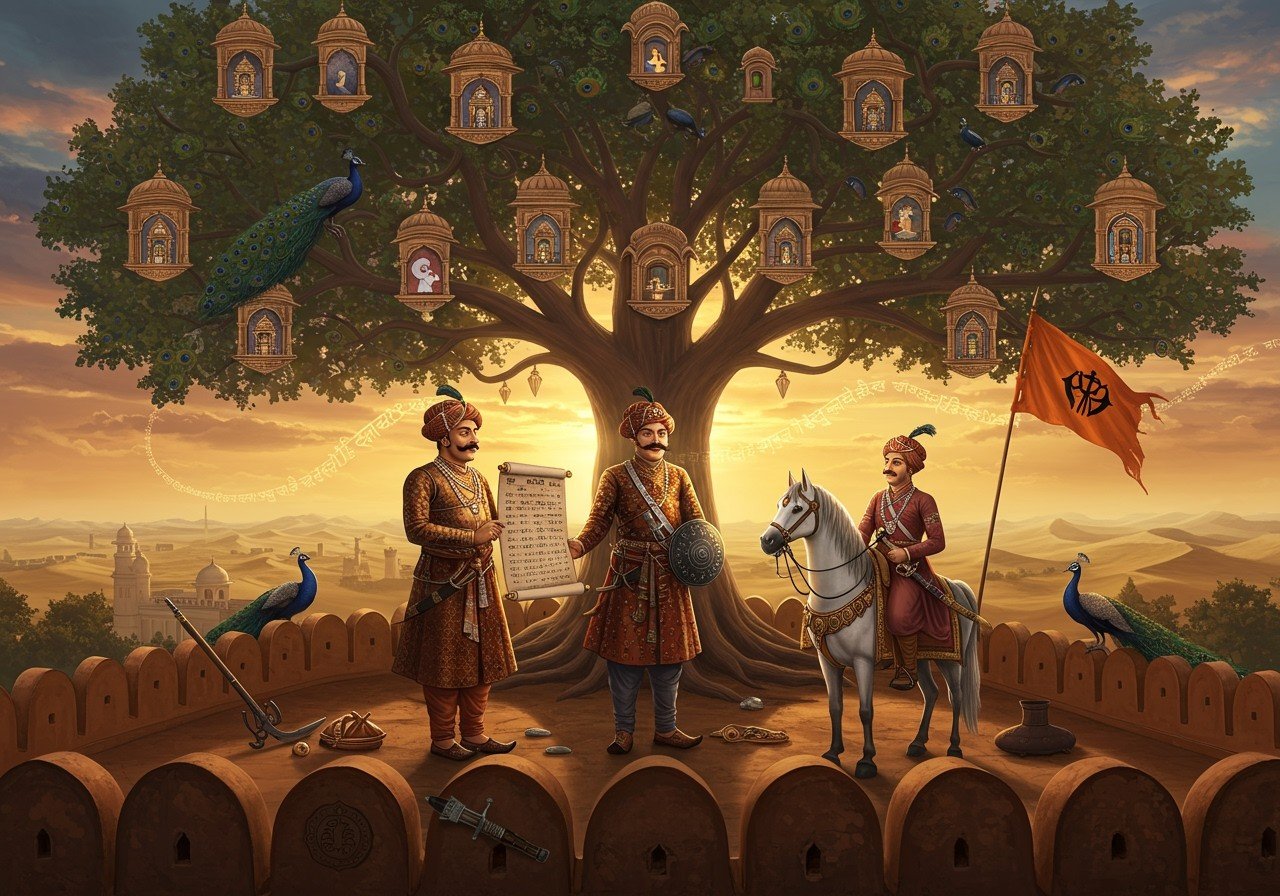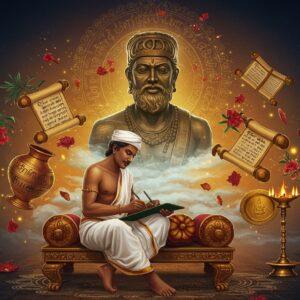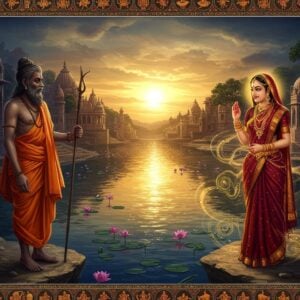
The Kshatriya lineage holds a special place in our vibrant Indian culture, deeply rooted in a rich tapestry of historical tradition. Surnames and gotras are like threads in this tapestry, intricately woven into the fabric of our identities, playing a vital role in identifying family heritage and lineage within the Indian caste system. The Rajput community, a cornerstone of the Kshatriya varna, is renowned for its warrior ethos and its indelible mark on history. Understanding our own gotra and surname is a way of honoring our ancestors, preserving cultural traditions, and cherishing the values that have been passed down through generations. This article delves into the significance of Kshatriya surnames, gotras, and vanshavali, specifically catering to those seeking a deeper understanding of their cultural roots and ancestral legacy.
Understanding Kshatriya Surnames
Kshatriya surnames carry the weight of ancient origins, evolving over centuries from designations of warrior clans to the family names we recognize today. These surnames are more than just labels; they represent social standing and identity within the community. Think of prominent Rajput surnames like Chauhan, Rathore, or Sisodia—each resonates with unique historical narratives and regional affiliations.
- Surnames reflect lineage and honor: They are a testament to our ancestors’ legacy, influencing marriage alliances and social interactions within the community. They speak volumes about where we come from and the values we uphold. These are the cornerstones of our identity.
- Martial traditions often mirrored in surnames: The warrior spirit of the Kshatriyas is often reflected in their surnames, showcasing not only their lineage but also their regional affiliations and the martial traditions they upheld. This martial heritage is a source of pride and inspiration.
- Historical events and migrations have shaped surname diversity: The passage of time, marked by historical events and migrations, has led to a fascinating diversification of Kshatriya surnames across India. Each surname tells a story of resilience, adaptation, and the enduring spirit of our ancestors.
Understanding the profound significance of these surnames helps maintain lineage continuity and safeguard the honor of our families, bridging the past with the present.
The Role of Gotras in Kshatriya Lineage
In the rich tapestry of Hindu tradition, the gotra represents the paternal line of a family, a thread that connects us to our ancestors. Originating from the wisdom of ancient Vedic sages, gotras serve to organize society and maintain the purity of lineage. For Kshatriyas, and particularly Rajputs, gotras hold immense significance, acting as a compass guiding us through the complexities of our cultural heritage.
Gotras link families to seven revered Rishis: Atri, Bharadwaj, Kashyap, Vashishth, Vishwamitra, Gautam, and Jamadagni. These connections aren’t merely symbolic; they provide a framework for religious rituals and marriage customs, ensuring the continuation of our traditions and the preservation of our cultural identity.
Many Rajput families proudly trace their lineage to specific gotras. For instance, you might find connections to Bharadwaj and Kashyap among them. This strengthens our bond with our ancestral past, enriching our understanding of the familial traditions and ceremonies that have shaped our lives. These gotras are living links to the wisdom and values of our forefathers.
Exploring Kshatriya Vanshavali
Vanshavali, our genealogical record, is a precious inheritance, tracing our family lineage through oral traditions and written chronicles. It’s a historical treasure trove, preserving Kshatriya legacies and documenting the achievements and valor of our ancestors. These records are not just about names and dates; they tell stories of courage, resilience, and the enduring spirit of our families.
Oral histories passed down through generations, ancient texts, and inscriptions all contribute to the compilation of vanshavali. These records are more than just historical documents; they’re a source of connection and belonging, reinforcing our shared heritage and reminding us of the strength and unity of our families. In today’s digital age, vanshavali offers a powerful way to reconnect with our roots, deepen our understanding of our familial history, and honor the legacy of those who came before us.
The Cultural Impact of Kshatriya Lineage
The influence of Kshatriya lineage on Indian culture is profound and far-reaching. Rajput warriors and their heroic deeds are immortalized in epics, ballads, and folk songs, inspiring generations with tales of courage and valor. Their traditions shape regional festivals and rituals, preserving a rich cultural heritage that continues to thrive today. Values like bravery, honor, and loyalty, deeply ingrained in the Kshatriya ethos, continue to impact contemporary society and family dynamics, guiding us in our interactions and shaping the values we pass on to our children.
Understanding our lineage fosters a sense of unity and pride within our communities, reinforcing our shared history and the bonds that tie us together. In the context of modern identity politics, Kshatriya lineage plays a role in caste dynamics and community interactions, shaping the social landscape and reminding us of the complexities of our cultural heritage.
Preserving and Celebrating Kshatriya Heritage
Kshatriya families actively preserve their heritage through gatherings, reunions, and ceremonies, keeping the flame of tradition alive. Historical monuments and museums stand as testaments to their history, inviting us to explore and appreciate the contributions of our ancestors. In today’s interconnected world, digital platforms offer new avenues for connecting family members and sharing lineage information, bridging geographical distances and strengthening the bonds of kinship.
Amidst the rapid pace of globalization, preserving our heritage faces new challenges. It requires conscious effort and a commitment to passing down our traditions to younger generations. Education and storytelling play a crucial role in this endeavor, ensuring that the wisdom and values of our ancestors continue to resonate in the hearts and minds of our children. By embracing these practices, we ensure cultural continuity for the future, safeguarding the legacy that has been entrusted to us.
How Poojn Helps Preserve Kshatriya Heritage
At Poojn.in, we are dedicated to supporting Kshatriya families in maintaining their sacred traditions and rituals by providing authentic puja items and expert guidance. As India’s largest Dashakarma bhandar, we deeply understand the profound connection between Kshatriya gotras and their patron deities like Lord Kartikeya, Lord Ganesha, Garuda, and Lord Indra. We believe that by honoring these traditions, we strengthen the fabric of our cultural heritage.
For Kshatriya families seeking to perform rituals and ceremonies with utmost reverence, Poojn.in offers a wide selection of items:
- Complete puja samagri kits: We offer meticulously curated puja samagri kits designed specifically for important Kshatriya ceremonies, ensuring that you have everything you need to perform these sacred rituals with reverence and authenticity. Shop our Pancha Sasya (Five Grains) and Panch Ratna (Five Jewels) for a truly blessed experience.
- Pure copper and brass items: We understand the importance of using pure materials for ritual offerings. Our collection of copper and brass items ensures that your offerings are made with the utmost purity and reverence.
- Traditional dhoop and agarbatti: Create a sacred atmosphere with our traditional dhoop and agarbatti, filling your home with the fragrant aromas that enhance your daily worship.
- Authentic rudraksha malas and sacred threads: Connect with your spiritual side with our authentic rudraksha malas and sacred threads, carefully crafted to enhance your connection to the divine.
- Ritual items for warrior deity worship: Honor the brave Kshatriya lineage with our specialized items for worshiping warrior deities.
- White Mustard Seeds: White mustard seeds hold significance in many traditions, available at Poojn.in for authentic rituals.
Our knowledgeable team is here to provide guidance on:
- Proper ritual procedures: We offer guidance on the proper ritual procedures based on specific gotras, ensuring that your ceremonies are performed with accuracy and authenticity.
- Selection of appropriate puja items: Our team can assist you in selecting the appropriate puja items for your specific needs, ensuring that your rituals are performed with the right materials and intentions.
- Deity-specific offerings and practices: We offer guidance on deity-specific offerings and practices, helping you personalize your worship and deepen your connection with the divine.
- Traditional Kshatriya customs and ceremonies: Our team is well-versed in traditional Kshatriya customs and ceremonies, offering valuable insights and guidance to ensure that your traditions are honored and preserved. Our experts in Bengali wedding traditions offer guidance on exquisite Topor Mukut sets, essential elements for these sacred rites. Explore our collection of Topor Mukut sets designed to enhance these special moments.
Contact us for personalized assistance:
- Phone: 03369029784
- WhatsApp: 9476142738
- Website: www.poojn.in
We ship across India, making it convenient for Kshatriya families everywhere to maintain their sacred traditions with authenticity and devotion. All our products are quality-checked and sourced from trusted vendors who understand the significance of ritual requirements.
Shop Now at Poojn.in for Traditional Puja Items
Embracing Our Ancestral Legacy
Understanding the depth and significance of Kshatriya surnames and gotras enriches our connection to the past, weaving us into a larger narrative that spans generations. These traditions are far more than just names; they represent the very essence of who we are, passed down through generations. They are the guiding stars of our rituals, shaping our values, and uniting us to a larger tapestry of history. As we navigate the complexities of the modern world, preserving and celebrating our Kshatriya heritage becomes not just a choice but a responsibility. Embracing our ancestral legacy is a way of paying homage to the valor and wisdom of our forebears, ensuring that these rich traditions continue to flourish for generations to come. In doing so, we not only preserve our cultural identity but also bequeath a legacy of pride, unity, and belonging to those who follow in our footsteps. This legacy enriches their lives and strengthens the bonds that tie us together as a community, woven together by the threads of tradition, respect, and shared identity. Learn more about the sacred sites associated with Parshuram at Parshuram’s Divine Legacy: Temples, Legends, and Rituals and Parshuram’s India: A Pilgrimage Guide to His Sacred Sites. Explore the historical significance of Parshuram temples in Rajasthan in Rajasthan’s Parshuram Temples: Legends and Desert History and Karnataka in Parshuram’s Temples: Karnataka and Beyond – A Journey Through History.
FAQs on Kshatriya Surnames and Gotras
What are Kshatriya surnames? Kshatriya surnames are family names associated with the warrior class in Indian society, reflecting the rich history and lineage of Kshatriyas, such as Rajput and other warrior clans. These surnames often carry a sense of pride and honor, connecting individuals to a long line of brave and influential ancestors. They serve as a marker of identity within the larger social fabric.
Why are Kshatriya gotras important? Kshatriya gotras hold deep cultural significance as they represent the ancestral lineage of a family, tracing back to ancient Vedic sages. Gotras are crucial for maintaining cultural and familial identity, playing a vital role in rituals like marriages and religious ceremonies. They help to preserve the unique traditions and customs associated with specific lineages.
What is Rajput history and lineage? Rajput history and lineage encompass the historical background and family trees of Rajput clans, who are traditionally considered part of the Kshatriya caste. This includes fascinating details about their origins, their remarkable achievements, and their enduring contributions to Indian history. It’s a story of valor, leadership, and a rich cultural heritage.
How can I find my Kshatriya vanshavali? Discovering your Kshatriya vanshavali, or family tree, involves researching historical records, consulting with family elders who hold valuable ancestral knowledge, or exploring online databases that document Kshatriya lineage. It’s a journey of discovery, connecting you to the roots of your family history.
Are all Rajputs considered Kshatriyas? Yes, Rajputs are traditionally classified as Kshatriyas. Their history is deeply intertwined with the warrior class, and they have a long and proud heritage of being rulers and warriors in India. Their contribution to the nation’s history is significant and well-documented.
Can Kshatriya gotras change over time? Gotras are typically passed down unchanged through generations, providing a sense of continuity and connection to the past. However, in some unique circumstances, gotras may evolve due to significant cultural shifts or intermarriage with other clans, reflecting the dynamism of culture and tradition.
What role do surnames play in Kshatriya identity? Surnames play a defining role in Kshatriya identity by linking individuals to their ancestral heritage. They act as a bridge to the past, connecting individuals to a larger story of valor, tradition, and belonging. They also distinguish individuals within the social hierarchy, reflecting the complexities of social structures and cultural heritage.
How do I learn more about Kshatriya history? Delving deeper into Kshatriya history involves exploring various resources: reading historical texts, visiting museums dedicated to Indian history, or engaging with online platforms that focus on Kshatriya heritage. Each avenue offers unique insights and perspectives, allowing you to piece together a comprehensive understanding of this rich and fascinating history.


